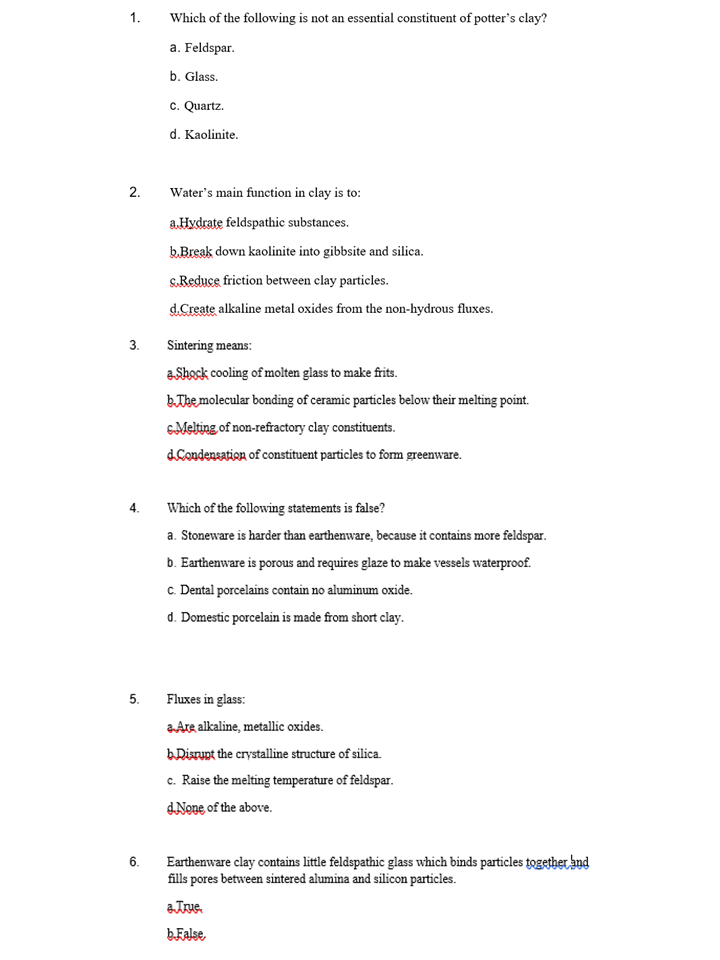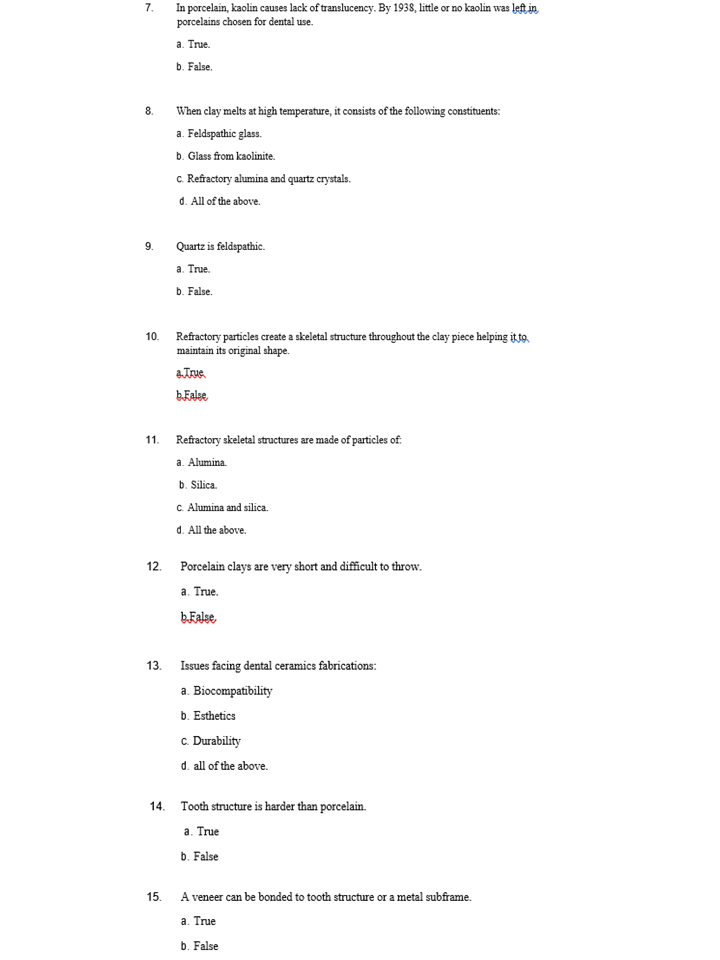1. Which of the following is not an essential constituent of potter's clay? a. Feldspar. b. Glass. c. Quartz. d. Kaolinite. 2. Water's main function in clay is to: aHydrate feldspathic substances. b.Break down kaolinite into gibbsite and silica. S.Reduce friction between clay particles. d.Create alkaline metal oxides from the non-hydrous fluxes. 3. Sintering means: 8Shosk cooling of molten glass to make frits. B.Tbe molecular bonding of ceramic particles below their melting point. GMelting of non-refractory clay constituents. dCondensation of constituent particles to form greenware. 4. Which of the following statements is false? a. Stoneware is harder than earthenware, because it contains more feldspar. b. Earthenware is porous and requires glaze to make vessels waterproof. c. Dental porcelains contain no aluminum oxide. d. Domestic porcelain is made from short clay. 5. Fluxes in glass: BAra alkaline, metallic oxides. WRisrupt the crystalline structure of silica. c. Raise the melting temperature of feldspar. dNeve of the above. Earthenware clay contains little feldspathic glass which binds particles together,bud fills pores between sintered alumina and silicon particles. 6. b.False.
1. Which of the following is not an essential constituent of potter's clay? a. Feldspar. b. Glass. c. Quartz. d. Kaolinite. 2. Water's main function in clay is to: aHydrate feldspathic substances. b.Break down kaolinite into gibbsite and silica. S.Reduce friction between clay particles. d.Create alkaline metal oxides from the non-hydrous fluxes. 3. Sintering means: 8Shosk cooling of molten glass to make frits. B.Tbe molecular bonding of ceramic particles below their melting point. GMelting of non-refractory clay constituents. dCondensation of constituent particles to form greenware. 4. Which of the following statements is false? a. Stoneware is harder than earthenware, because it contains more feldspar. b. Earthenware is porous and requires glaze to make vessels waterproof. c. Dental porcelains contain no aluminum oxide. d. Domestic porcelain is made from short clay. 5. Fluxes in glass: BAra alkaline, metallic oxides. WRisrupt the crystalline structure of silica. c. Raise the melting temperature of feldspar. dNeve of the above. Earthenware clay contains little feldspathic glass which binds particles together,bud fills pores between sintered alumina and silicon particles. 6. b.False.
Principles of Modern Chemistry
8th Edition
ISBN:9781305079113
Author:David W. Oxtoby, H. Pat Gillis, Laurie J. Butler
Publisher:David W. Oxtoby, H. Pat Gillis, Laurie J. Butler
Chapter22: Inorganic Materials
Section: Chapter Questions
Problem 7P
Related questions
Question
Hello! I asked this question and it was rejected. Just for clarification, this is not a graded test. I found this in a document in an online course and wanted to check if my answers were correct or not.

Transcribed Image Text:1.
Which of the following is not an essential constituent of potter's clay?
a. Feldspar.
b. Glass.
c. Quartz.
d. Kaolinite.
2.
Water's main function in clay is to:
aHydrate feldspathic substances.
b.Break down kaolinite into gibbsite and silica.
s.Reduce friction between clay particles.
d.Create alkaline metal oxides from the non-hydrous fluxes.
3.
Sintering means:
aShosk cooling of molten glass to make frits.
bJbe molecular bonding of ceramic particles below their melting point.
GMelting of non-refractory clay constituents.
dCondensation of constituent particles to form greenware.
4.
Which of the following statements is false?
a. Stoneware is harder than earthenware, because it contains more feldspar.
b. Earthenware is porous and requires glaze to make vessels waterproof.
c. Dental porcelains contain no aluminum oxide.
d. Domestic porcelain is made from short clay.
5.
Fluxes in glass:
LAre alkaline, metallic oxides.
bDisrupt the crystalline structure of silica.
c. Raise the melting temperature of feldspar.
dNone of the above.
Earthenware clay contains little feldspathic glass which binds particles together bnd
fills pores between sintered alumina and silicon particles.
6.
bFalse,

Transcribed Image Text:In porcelain, kaolin causes lack of translucency. By 1938, little or no kaolin was left in
porcelains chosen for dental use.
7.
a. True.
b. False.
8.
When clay melts at high temperature, it consists of the following constituents:
a. Feldspathic glass.
b. Glass from kaolinite.
c. Refractory alumina and quartz crystals.
d. All of the above.
9.
Quartz is feldspathic.
а. True.
b. False.
10. Refractory particles create a skeletal structure throughout the clay piece helping it9.
maintain its original shape.
11.
Refractory skeletal structures are made of particles of.
a. Alumina.
b. Silica.
C. Alumina and silica.
d. All the above.
12.
Porcelain clays are very short and difficult to throw.
a. True.
bFalse
13.
Issues facing dental ceramics fabrications:
a. Biocompatibility
b. Esthetics
c. Durability
d. all of the above.
14. Tooth structure is harder than porcelain.
а. True
b. False
15.
A veneer can be bonded to tooth structure or a metal subframe.
a. True
b. False
Expert Solution
This question has been solved!
Explore an expertly crafted, step-by-step solution for a thorough understanding of key concepts.
This is a popular solution!
Trending now
This is a popular solution!
Step by step
Solved in 3 steps

Knowledge Booster
Learn more about
Need a deep-dive on the concept behind this application? Look no further. Learn more about this topic, chemistry and related others by exploring similar questions and additional content below.Recommended textbooks for you

Principles of Modern Chemistry
Chemistry
ISBN:
9781305079113
Author:
David W. Oxtoby, H. Pat Gillis, Laurie J. Butler
Publisher:
Cengage Learning

Physical Chemistry
Chemistry
ISBN:
9781133958437
Author:
Ball, David W. (david Warren), BAER, Tomas
Publisher:
Wadsworth Cengage Learning,

Principles of Modern Chemistry
Chemistry
ISBN:
9781305079113
Author:
David W. Oxtoby, H. Pat Gillis, Laurie J. Butler
Publisher:
Cengage Learning

Physical Chemistry
Chemistry
ISBN:
9781133958437
Author:
Ball, David W. (david Warren), BAER, Tomas
Publisher:
Wadsworth Cengage Learning,